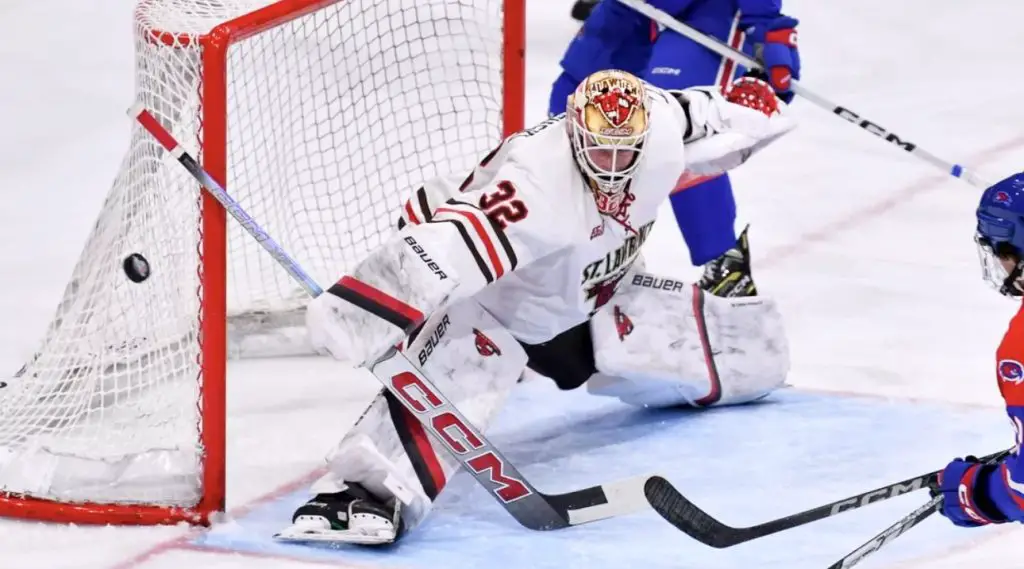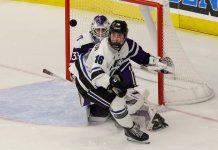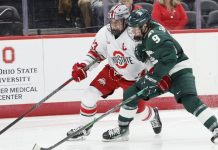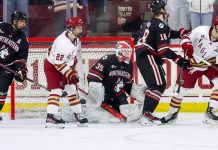
The college hockey season doesn’t typically shift into overdrive until the calendar shifts into the new year.
The “first half,” loaded to the gills with its high-profile nonconference matchups, holiday tournaments and pleasant surprises, doesn’t truly yield its heat until league play and trophy season crests over the horizon. Early-season rivalries aside, coaches and players are acutely aware how seasons can be lost in the first half, but championships are won after New Year’s Day.
Slumbering giants from the first half of the year aren’t immune to thunderous awakenings after they return from Christmas break, and in the outer reaches of New York’s North Country, there are plenty of reasons to believe in St. Lawrence’s opportunity for a second half run. Mired in last place at the end of the first half, a four-point weekend against Dartmouth and Harvard sprung the Saints from a doldrums that not even this past weekend’s 8-1 loss to Vermont can overshadow as the real season – the real run to Lake Placid – begins in earnest.
“We had a really good start,” said Saints coach Brent Brekke. “And we were scoring goals. During part of that stretch, we played Ferris State and went 6-for-8 on the power play, which obviously if you can go 6-for-8 on the power play, that’s a rarity but it leaves you feeling like there’s a sign of great things to come. After that, though, we went dormant on the power play, and after those first six games, when we’re all of a sudden not scoring, [guys] started to squeeze the stick and look for the extra pass, which got us away from the things that we needed to do to have success. Sitting down and watching a lot of the video, we needed to simplify things and be confident that we could make those kinds of plays when, at times, less was more.”
Plenty of reasons exist for anyone choosing to believe in St. Lawrence’s second half run. One of last year’s best defensive teams in the league, the Saints have actually cut and sliced their goals against average by a half-goal per game in their first six ECAC games. At an overall level, SLU is still one of the middle-tier teams in the league, and removing the eight goals allowed against the Catamounts lowers the number by nearly a quarter-goal against the team’s overall average on the 2024-25 season.
Further considering that game’s outlier status, the Saints align closer to the nation’s 25 best defenses and are pushed closer to Wisconsin, Cornell and Quinnipiac, which entered the second half in first place after its own early-season struggles.
Problems existed on the offensive side for a team that barely nudged its way north of one goal per game in its league games through its first six games, but the get-right weekend against Dartmouth and Harvard enabled the Saints to push goals across the Big Green’s goal mouth after losing one-goal leads on two separate occasions.
“Our penalty kill has been great all year,” Brekke said. “[Assistant coach] Tommy Hill runs our penalty kill and does a phenomenal job at it, and that’s always been, for us, strengthening. Combine that with Mason Kucenski in goal, where he’s been dynamite for us and so sound, and we feel that good to play in a tight game, even if we haven’t been producing the offense. We feel that we can give ourselves a good position if we hold a team to two goals or under three goals because we’ll start putting some pucks in the net.
“It’s not going to be a one-line change for us. It’s going to take four lines. We’re going to need our power play to click, but defensively, knowing that we can minimize an opponent’s quality opportunities in front of Mason, who is a stalwart, that’s the confidence that we know we can use to give [the defense] its support.”
It won’t hurt that every single team has to visit the North Country over the next two months. Even with a 5-12-1 overall record, St. Lawrence is defending home ice to the tune of four wins, and last year’s team went 10-5-2 at Appleton Arena during a season in which it went 3-13-4 away from its home building. There hasn’t been a sub-.500 year at home since the COVID-19 pandemic ended, and the Saints haven’t played poorly as a home team since the building reopened from its renovation in 2019-20.
And like last year, St. Lawrence has a built-in advantage in the winter months where the Saints don’t travel on consecutive weekends, a fact underscored by their 4-1-1 ECAC record on home Saturdays last season. One of those wins was against travel partner Clarkson, but the loss to Princeton still went to overtime and followed a Friday night overtime win over Quinnipiac, which was ranked No. 5 in the nation at the time.
“We want it to be a tough building to play in,” Brekke said. “It’s a sense of pride for us that it doesn’t matter who we play. Things happen fast here. It’s a great old rink, and it has a couple of interesting [facets]. It’s a little bit darker, and when you come here, if there’s bad weather, when you step into a darker building, it all [combines] against a team playing an aggressive style and physical style. This is a challenging trip [for teams], and we want it to stay challenging. But at the same time, it’s on us to make it a tough place to play. We have to make it so [players] just want this game to be over, that they don’t want to be here.
“We have to go after them like a tidal wave, where we’re relentless with and without the puck.”
St. Lawrence returns to the ice for its home series with Rensselaer and Union this weekend with both games scheduled for 7 p.m. before the Saints head east to play Brown and Yale on Jan. 17-18. A home-and-home with Clarkson follows on Jan. 24-25 with Friday night in Canton before turning the clock to Potsdam for a Saturday night matchup.


